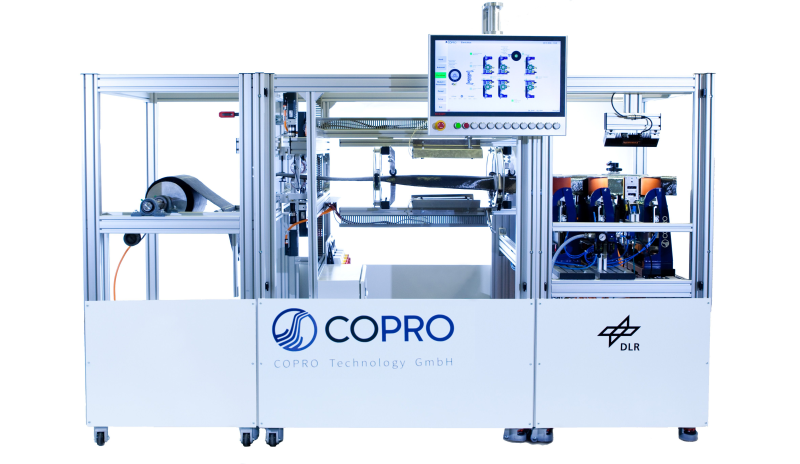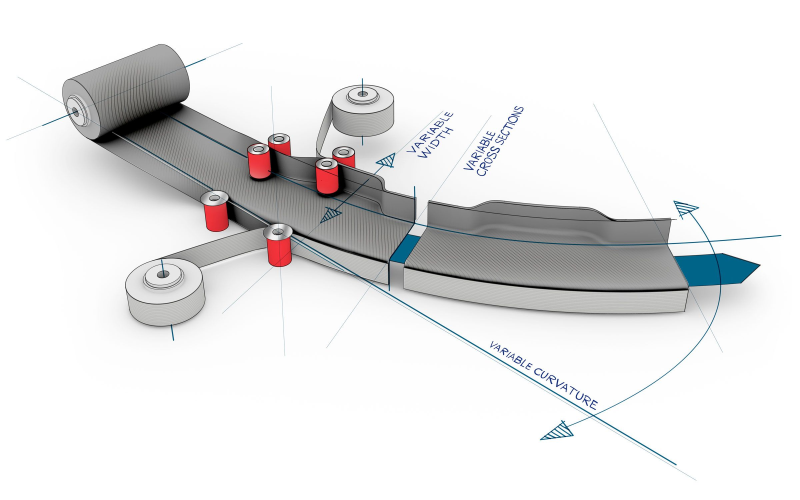For the first time, process automation for preforming semi-finished products from carbon fibre-reinforced plastics is successful with image processing technology from Cognex

Process control in automated preforming is considered to be difficult. At the German Aerospace Centre (DLR), the automation specialist ISW has succeeded in process-stably automating the COPROâ process using a Cognex image-based camera system, and making it profitable. With the new, patented technology, the cost of CFRP components can now be significantly reduced and quality and reproducibility increased.
 In the COPRO process, preform intermediates for the production of composite components can now be series manufactured in a process-safe and cost-efficient manner. The innovation drivers Arne Stahl and Henrik Borgwardt founded the company COPRO Technology in Braunschweig in order to make this technology commercially available across all industries. In the modular system developed by them, rotating rollers with freely selectable rotational speeds are used to continuously and gently transform textile semi-finished products.
In the COPRO process, preform intermediates for the production of composite components can now be series manufactured in a process-safe and cost-efficient manner. The innovation drivers Arne Stahl and Henrik Borgwardt founded the company COPRO Technology in Braunschweig in order to make this technology commercially available across all industries. In the modular system developed by them, rotating rollers with freely selectable rotational speeds are used to continuously and gently transform textile semi-finished products.
In the storage module of the system there are rollers which unwind a fibre ribbon and feed the process without tension. It is aligned and preformed in the feed module. Here, heating of the binder also takes place, which is already present in small amounts on the material. It serves to stabilize the geometry after forming and connect several layers to a preform.  Preforms with freely adjustable radii of curvature are produced in the subsequent forming module. This is achieved by stepless variation of the speed difference between the rotating rollers, which move the material continuously and feed it in fixed paths at speeds of up to 30 m/min. Optical sensors and a vision system from Cognex are used for real-time control of the preforming process.
Preforms with freely adjustable radii of curvature are produced in the subsequent forming module. This is achieved by stepless variation of the speed difference between the rotating rollers, which move the material continuously and feed it in fixed paths at speeds of up to 30 m/min. Optical sensors and a vision system from Cognex are used for real-time control of the preforming process.
A camera registers the material seam
 The fibre material is inhomogeneous and very flexible, making process management difficult. A robust process results when the path guidance of the fibre material is continuously controlled. Accurate path guidance can be realized by changing the angle of incidence of the rollers. The Cognex In-Sight 5403 camera is used for this purpose. It detects material edges and provides all the necessary information for precise material flow control.
The fibre material is inhomogeneous and very flexible, making process management difficult. A robust process results when the path guidance of the fibre material is continuously controlled. Accurate path guidance can be realized by changing the angle of incidence of the rollers. The Cognex In-Sight 5403 camera is used for this purpose. It detects material edges and provides all the necessary information for precise material flow control.
 Cognex image processing systems are unequalled with regard to testing, identifying and routing parts. The self-contained and industry-capable camera systems have extremely fast image processing, including highly-developed vision tools. For this reason, they are the first choice for the system integrator ISW (Industrial Sensor Systems Wichmann), a specialist for demanding image processing solutions for 25 years.
Cognex image processing systems are unequalled with regard to testing, identifying and routing parts. The self-contained and industry-capable camera systems have extremely fast image processing, including highly-developed vision tools. For this reason, they are the first choice for the system integrator ISW (Industrial Sensor Systems Wichmann), a specialist for demanding image processing solutions for 25 years.
Regarding the starting situation, Stefan Tukac from ISW said: “Our first goal was to stabilize the process and ensure process capability.” The Cognex In-Sight 5403 detects the position of the outermost material seam with a measurement accuracy of +/- 0.2 mm and transmits the data to the Beckhoff control system. By continually detecting the current material position and calculating deviation, the control system immediately adjusts the angle of attack of the rollers so that the material returns to the desired position.
This is where rapid and precise control is required, which is only possible with a powerful and reliable vision sensor. The Cognex In-Sight 5403 is a rugged and industrial-suited 2-MP camera mounted in a sturdy aluminium die-cast housing with protection class IP 67. It is used wherever high resolutions and high accuracies are required. With its 1600 x 1200 pixels, the In-Sight 5403 does not miss – whether large parts are checked for small defects or, as here, precise measurements have to be made at high speeds.
High resolution and integrated lighting
 In addition to high resolution, short response times and good spatial integration are particularly important in the COPRO system. Despite its high resolution with complete overall image capture, the In-Sight 5403 achieves an image frequency of 15 fps. The unit is also very compact and can be integrated almost anywhere and easily applied. In the COPRO system, the camera is attached to a mounting plate that allows easy adjustment. As summed up by Tupac: “The little time required for commissioning was a great advantage. An I/O breakout module and extensions ensure simple connection of the In-Sight systems.”
In addition to high resolution, short response times and good spatial integration are particularly important in the COPRO system. Despite its high resolution with complete overall image capture, the In-Sight 5403 achieves an image frequency of 15 fps. The unit is also very compact and can be integrated almost anywhere and easily applied. In the COPRO system, the camera is attached to a mounting plate that allows easy adjustment. As summed up by Tupac: “The little time required for commissioning was a great advantage. An I/O breakout module and extensions ensure simple connection of the In-Sight systems.”
COPRO image processing depends on optimally adapted lighting as the carbon fibres reflect quite intensely, so that in the worst case seams are excessively radiated by reflection, making them invisible. Homogeneous irradiation is achieved by means of suitable illumination and clear contrast between carbon fibres and polyamide seam threads. In-Sight 5403 is fitted with integrated ring lighting, which readily provides optimal lighting with good basic illumination. In order to obtain the best possible image, the Cognex camera also offers the possibility of controlling external lighting, as well as options for direct and diffuse light, and modules for light rings, spots and strips.
Software determines process success
 Software plays a special role in the COPRO application. Regarding this Tukac said: “Edges are identified and seams tracked with the aid of powerful software. The modularly designed plug-and-play system can be calibrated and scaled if it needs to be used for several lines.” The solution from ISW is based on the Cognex In-Sight Explorer software. Besides alignment, guidance and measurement applications, test and error detection routines can also be set up in a simple manner with its spreadsheet user interface. The software provides tools for blob, edge, curve and line detection, histogram and geometry tools as well as filters. The Vision tools can be flexibly and efficiently configured in the In-Sight Explorer spreadsheet. The VisionView visualization tool makes it possible to monitor and control the Cognex camera used in the COPRO system.
Software plays a special role in the COPRO application. Regarding this Tukac said: “Edges are identified and seams tracked with the aid of powerful software. The modularly designed plug-and-play system can be calibrated and scaled if it needs to be used for several lines.” The solution from ISW is based on the Cognex In-Sight Explorer software. Besides alignment, guidance and measurement applications, test and error detection routines can also be set up in a simple manner with its spreadsheet user interface. The software provides tools for blob, edge, curve and line detection, histogram and geometry tools as well as filters. The Vision tools can be flexibly and efficiently configured in the In-Sight Explorer spreadsheet. The VisionView visualization tool makes it possible to monitor and control the Cognex camera used in the COPRO system.
Results and outlook
 COPRO technology is the future alternative for the production of CFK profiles with solid tools: In the fully automatic and continuous COPRO process, costs can be reduced by up to 35% compared to discontinuous robot preforming. The process can be easily integrated into existing production lines. Cognex Designer image processing software will be used in the future – an integrated development environment for 2-D multi-camera and 3-D image processing applications. Use of the new Cognex In-Sight VC200 systems is also conceivable: The recently presented Multi-Smart Camera Vision systems bring the proven performance and reliability of In-Sight image processing to multi-camera applications.
COPRO technology is the future alternative for the production of CFK profiles with solid tools: In the fully automatic and continuous COPRO process, costs can be reduced by up to 35% compared to discontinuous robot preforming. The process can be easily integrated into existing production lines. Cognex Designer image processing software will be used in the future – an integrated development environment for 2-D multi-camera and 3-D image processing applications. Use of the new Cognex In-Sight VC200 systems is also conceivable: The recently presented Multi-Smart Camera Vision systems bring the proven performance and reliability of In-Sight image processing to multi-camera applications.
Author: Cécile Jacquin, Marcom Specialist, Cognex Inc.

